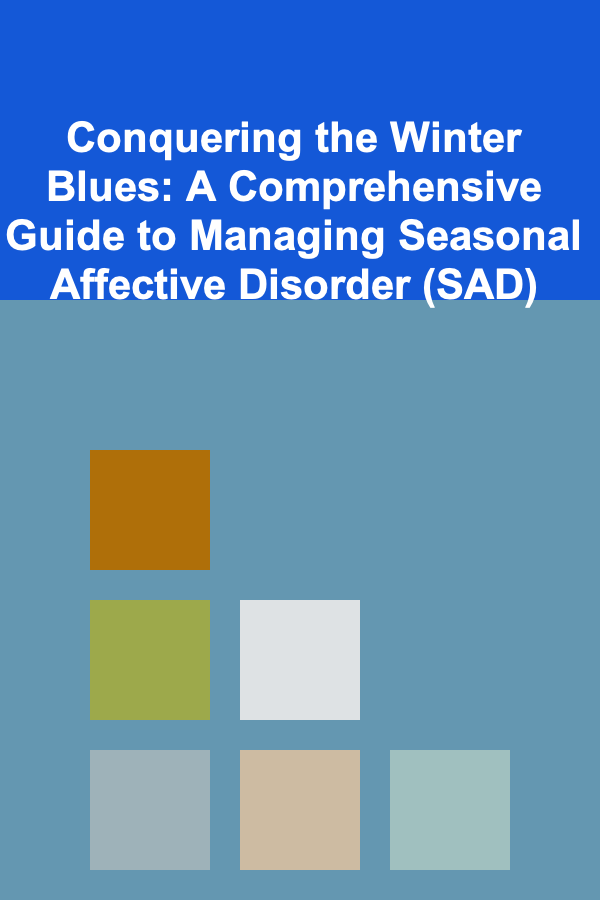
Conquering the Winter Blues: A Comprehensive Guide to Managing Seasonal Affective Disorder (SAD)
ebook include PDF & Audio bundle (Micro Guide)
$12.99$11.99
Limited Time Offer! Order within the next:

As the days grow shorter and the sunlight dwindles, many experience more than just a passing case of the "winter blues." For some, this seasonal shift triggers a more profound and debilitating condition known as Seasonal Affective Disorder (SAD). SAD is a type of depression that follows a seasonal pattern, typically starting in the fall or winter and remitting in the spring or summer. Understanding SAD, its symptoms, and effective management strategies is crucial for individuals seeking to reclaim their well-being during the darker months.
Understanding Seasonal Affective Disorder
SAD is not simply a case of feeling down during the winter months. It's a recognized mood disorder with specific diagnostic criteria. While the exact cause of SAD remains under investigation, research points to several contributing factors:
- Disrupted Circadian Rhythm: Reduced sunlight exposure during fall and winter can disrupt the body's internal clock, known as the circadian rhythm. This clock regulates sleep-wake cycles, hormone release, and other vital bodily functions. When disrupted, it can lead to imbalances in mood and energy levels.
- Serotonin Imbalance: Serotonin, a neurotransmitter associated with mood regulation, is affected by sunlight. Lower sunlight exposure can lead to decreased serotonin activity, potentially contributing to depressive symptoms.
- Melatonin Overproduction: Melatonin, a hormone that regulates sleep, is produced in response to darkness. In winter, with longer nights and shorter days, the body may produce more melatonin, leading to feelings of drowsiness and lethargy.
- Vitamin D Deficiency: Sunlight is essential for the body to produce vitamin D. Reduced sunlight exposure during winter months can lead to vitamin D deficiency, which has been linked to depression and other health problems.
It's important to distinguish SAD from other forms of depression. The key characteristic of SAD is its seasonal pattern. Symptoms typically emerge around the same time each year and subside with the return of longer days. While anyone can experience temporary sadness or low energy during the winter, SAD represents a more persistent and significant impairment in daily functioning.
Recognizing the Symptoms of SAD
SAD symptoms can vary in severity from person to person. It's crucial to be aware of the common signs and symptoms so that you can seek appropriate help if needed. The symptoms of SAD are often similar to those of major depression, but they specifically occur during the fall and winter months. Common symptoms include:
- Persistent Sadness or Low Mood: A pervasive feeling of sadness, hopelessness, or emptiness that lasts for most of the day, nearly every day.
- Loss of Interest or Pleasure: A significant decrease in interest or pleasure in activities that were once enjoyable. This can extend to hobbies, social interactions, and even basic self-care.
- Fatigue and Low Energy: Feeling tired and sluggish, even after adequate sleep. Difficulty concentrating or focusing on tasks.
- Changes in Sleep Patterns: Oversleeping (hypersomnia) or difficulty staying awake during the day. While insomnia is common in other forms of depression, SAD often involves increased sleep.
- Changes in Appetite or Weight: Increased appetite, particularly for carbohydrates, leading to weight gain. This can manifest as cravings for sugary or starchy foods.
- Difficulty Concentrating: Problems focusing, remembering things, or making decisions. This can impact work or school performance.
- Irritability: Increased irritability, restlessness, or agitation. Feeling easily frustrated or annoyed.
- Social Withdrawal: Tendency to isolate oneself from friends and family. Avoiding social gatherings or activities.
- Feelings of Hopelessness or Worthlessness: Negative thoughts about oneself and the future. Self-criticism and feelings of inadequacy.
- Thoughts of Death or Suicide: In severe cases, SAD can lead to suicidal thoughts or ideations. It is crucial to seek immediate help if you are experiencing these thoughts.
It's important to note that not everyone with SAD will experience all of these symptoms. The severity and combination of symptoms can vary. If you are experiencing several of these symptoms for a prolonged period and they are significantly impacting your daily life, it's essential to consult with a healthcare professional for diagnosis and treatment.
Light Therapy: Shining a Light on SAD Relief
Light therapy is often considered the first-line treatment for SAD. It involves sitting in front of a special light box that emits bright, artificial light that mimics natural sunlight. The light box helps to regulate the body's circadian rhythm, suppress melatonin production, and boost serotonin levels. Here's a breakdown of light therapy:
- How it Works: Light boxes typically emit 10,000 lux of light, which is much brighter than ordinary indoor lighting. The light enters the eyes and stimulates the retina, which then sends signals to the brain that affect mood and hormone regulation.
- Choosing a Light Box: Look for a light box that emits 10,000 lux of light and filters out harmful ultraviolet (UV) rays. Ensure the box is medically certified and adheres to safety standards. Consult with your doctor or a qualified healthcare professional for recommendations.
- Proper Usage: Sit comfortably in front of the light box for 20-30 minutes each morning, ideally soon after waking up. Position the light box about 12-24 inches away from your face, but do not look directly at the light. You can read, work, or eat while using the light box.
- Timing is Key: Consistency is crucial for light therapy to be effective. Use the light box every day, even on sunny days, during the fall and winter months. Some people find that starting light therapy before symptoms begin can help prevent SAD from developing.
- Potential Side Effects: Light therapy is generally safe, but some people may experience mild side effects, such as headaches, eye strain, nausea, or insomnia. These side effects are usually temporary and can be minimized by adjusting the duration or distance of the light therapy. If you have any concerns, consult with your doctor.
- Contraindications: Light therapy may not be suitable for everyone. Individuals with certain eye conditions, such as macular degeneration or cataracts, or those taking photosensitizing medications should consult with their doctor before using light therapy.
Light therapy can be a highly effective treatment for SAD, but it's essential to use it correctly and consistently. It's also important to consult with a healthcare professional to determine if light therapy is the right treatment option for you and to receive guidance on how to use it safely and effectively.
Medication: Exploring Pharmaceutical Options
Antidepressant medication, particularly selective serotonin reuptake inhibitors (SSRIs), can be an effective treatment for SAD, especially when symptoms are severe or when other treatments haven't provided sufficient relief. SSRIs work by increasing the levels of serotonin in the brain, which can help to improve mood and alleviate depressive symptoms. Here's what you should know about medication for SAD:
- SSRIs: SSRIs are the most commonly prescribed antidepressants for SAD. They are generally well-tolerated and have fewer side effects than older antidepressants. Common SSRIs used for SAD include sertraline (Zoloft), paroxetine (Paxil), fluoxetine (Prozac), and citalopram (Celexa).
- Bupropion (Wellbutrin): Bupropion is another antidepressant that may be used to treat SAD. It works differently than SSRIs by affecting the levels of dopamine and norepinephrine in the brain. Bupropion can be particularly helpful for individuals experiencing fatigue and low energy.
- Timing of Treatment: Medication is often started in the fall, before symptoms become severe, and continued throughout the winter months. Some individuals may need to continue medication year-round to prevent recurrence of SAD.
- Dosage and Monitoring: The dosage of medication will vary depending on the individual and the severity of their symptoms. It's important to work closely with your doctor to find the right dosage and to monitor for any side effects.
- Potential Side Effects: Antidepressants can cause side effects, such as nausea, insomnia, weight gain, sexual dysfunction, and dry mouth. These side effects are usually mild and temporary, but it's important to discuss any concerns with your doctor.
- Tapering Off Medication: It's important not to stop taking antidepressants abruptly, as this can lead to withdrawal symptoms. Your doctor will gradually taper off the medication when it's time to discontinue treatment.
Medication can be a valuable tool in managing SAD, but it's not a one-size-fits-all solution. It's essential to have a thorough discussion with your doctor about the potential benefits and risks of medication and to explore other treatment options as well. Medication is often used in conjunction with light therapy and other lifestyle changes.
Therapy: Talking Your Way to Wellness
Psychotherapy, or talk therapy, can be a valuable component of SAD treatment, especially when combined with other interventions like light therapy and medication. Therapy provides a safe and supportive space to explore the underlying issues contributing to SAD and to develop coping skills for managing symptoms. Here's a look at the types of therapy commonly used for SAD:
- Cognitive Behavioral Therapy (CBT): CBT is a type of therapy that focuses on identifying and changing negative thought patterns and behaviors that contribute to depression. For SAD, CBT may involve challenging negative thoughts about winter, developing strategies for coping with low energy and fatigue, and learning to engage in enjoyable activities despite feeling unmotivated. Specifically for SAD, a variant called CBT-SAD is often employed. CBT-SAD focuses on shifting negative thoughts specifically related to winter and increasing engagement in pleasurable activities.
- Interpersonal Therapy (IPT): IPT focuses on improving relationships and social skills. SAD can often lead to social withdrawal and isolation, which can worsen symptoms. IPT helps individuals identify and address relationship issues that may be contributing to their depression and to develop healthier ways of relating to others.
- Mindfulness-Based Therapies: Mindfulness-based therapies, such as mindfulness-based stress reduction (MBSR), teach individuals to pay attention to the present moment without judgment. Mindfulness practices can help reduce stress, improve mood, and increase self-awareness. They can also help individuals cope with the physical and emotional symptoms of SAD, such as fatigue and low energy.
- Benefits of Therapy: Therapy can provide a number of benefits for individuals with SAD, including:
- Improved coping skills for managing symptoms.
- Reduced negative thoughts and feelings.
- Increased self-awareness and understanding.
- Improved relationships and social support.
- Increased motivation and engagement in activities.
Finding a therapist who is experienced in treating SAD is essential. Look for a therapist who is licensed and has specific training in CBT, IPT, or other evidence-based therapies for depression. Therapy can be a powerful tool for reclaiming your well-being and living a fulfilling life, even during the winter months.
Lifestyle Adjustments: Empowering Yourself Through Daily Habits
In addition to light therapy, medication, and therapy, making certain lifestyle adjustments can significantly impact your experience with SAD. These changes focus on optimizing your physical and mental well-being, particularly during the challenging winter months.
- Maximize Sunlight Exposure: Take advantage of any available sunlight. Open curtains, sit near windows, and spend time outdoors during daylight hours, even on cloudy days. A short walk outside can make a significant difference in your mood and energy levels. Consider using a dawn simulator, which gradually increases light in your bedroom before you wake up.
- Regular Exercise: Exercise is a powerful mood booster. Aim for at least 30 minutes of moderate-intensity exercise most days of the week. Even a brisk walk, a dance class, or a workout at the gym can help to reduce stress, improve mood, and increase energy levels. Consider outdoor activities when weather permits, even if it's just a short walk in the park.
- Healthy Diet: A balanced diet is essential for overall health and well-being. Focus on eating plenty of fruits, vegetables, whole grains, and lean protein. Limit processed foods, sugary drinks, and excessive caffeine. Pay attention to your vitamin D intake, and consider taking a supplement if you are deficient. Also, be mindful of carbohydrate cravings, which are common in SAD. Choose complex carbohydrates over simple sugars to maintain stable blood sugar levels and avoid energy crashes.
- Prioritize Sleep: Establish a regular sleep schedule, going to bed and waking up at the same time each day, even on weekends. Create a relaxing bedtime routine to help you wind down before sleep. Avoid screen time (phones, tablets, computers) for at least an hour before bed. Ensure your bedroom is dark, quiet, and cool.
- Stress Management Techniques: Chronic stress can worsen SAD symptoms. Practice stress-reducing techniques, such as yoga, meditation, deep breathing exercises, or progressive muscle relaxation. Engage in activities that you find enjoyable and relaxing, such as reading, listening to music, or spending time in nature.
- Social Connection: Combat social withdrawal by making an effort to connect with friends and family. Schedule regular social activities, even if you don't feel like it. Join a club or group that aligns with your interests. Volunteering can also be a great way to connect with others and feel a sense of purpose.
- Plan a Winter Getaway: If possible, consider planning a trip to a sunny destination during the winter months. Even a short break from the cold and darkness can help to improve your mood and energy levels.
- Mindful Consumption of News and Media: Limit exposure to negative news and social media, which can exacerbate feelings of anxiety and depression. Focus on positive and uplifting content.
These lifestyle adjustments can empower you to take control of your well-being and manage SAD symptoms more effectively. Remember that small changes can make a big difference over time. Be patient with yourself and celebrate your progress along the way.
Vitamin D: The Sunshine Vitamin's Role in SAD
Vitamin D, often referred to as the "sunshine vitamin," plays a crucial role in various bodily functions, including mood regulation. As mentioned earlier, reduced sunlight exposure during winter months can lead to vitamin D deficiency, which has been linked to an increased risk of depression, including SAD. Here's a closer look at the connection between vitamin D and SAD:
- Vitamin D and Brain Function: Vitamin D receptors are found throughout the brain, including areas involved in mood regulation, such as the hypothalamus and the amygdala. Vitamin D is believed to influence the production and activity of neurotransmitters, such as serotonin and dopamine, which play a key role in mood and well-being.
- Studies on Vitamin D and Depression: Research has shown a correlation between low vitamin D levels and an increased risk of depression. Some studies have found that vitamin D supplementation can improve mood and reduce depressive symptoms, particularly in individuals who are deficient in vitamin D.
- Vitamin D and SAD: While more research is needed, some studies suggest that vitamin D supplementation may be beneficial for individuals with SAD. A systematic review and meta-analysis of several studies indicated that vitamin D supplementation may have a small to moderate effect on reducing depressive symptoms in individuals with SAD.
- Checking Your Vitamin D Levels: It's a good idea to have your vitamin D levels checked by your doctor, especially if you are experiencing symptoms of SAD or other mood disorders. A simple blood test can determine if you are deficient in vitamin D.
- Vitamin D Supplementation: If you are deficient in vitamin D, your doctor may recommend taking a vitamin D supplement. The recommended dosage will vary depending on your individual needs and the severity of your deficiency. It's important to follow your doctor's instructions regarding dosage and to monitor your vitamin D levels regularly.
- Food Sources of Vitamin D: While sunlight is the primary source of vitamin D, you can also obtain it from certain foods, such as fatty fish (salmon, tuna, mackerel), egg yolks, and fortified foods (milk, yogurt, cereal). However, it can be difficult to get enough vitamin D from food alone, especially during the winter months.
- Important Considerations: Vitamin D supplementation should be approached with caution. Taking excessive amounts of vitamin D can lead to toxicity. It's important to consult with your doctor before starting vitamin D supplementation, especially if you have any underlying health conditions or are taking any medications.
While vitamin D supplementation may be a helpful addition to your SAD management plan, it's important to remember that it's not a cure-all. It's best used in conjunction with other evidence-based treatments, such as light therapy, medication, therapy, and lifestyle adjustments.
When to Seek Professional Help
While self-management strategies can be helpful for mild cases of SAD, it's crucial to seek professional help if your symptoms are severe, persistent, or significantly impacting your daily life. Here are some signs that it's time to consult with a healthcare professional:
- Symptoms are Interfering with Daily Functioning: If your symptoms are making it difficult to work, go to school, maintain relationships, or engage in basic self-care activities, it's time to seek help.
- Symptoms are Worsening: If your symptoms are becoming more severe or frequent, or if you are experiencing new or worsening symptoms, it's important to consult with a healthcare professional.
- Self-Management Strategies are Not Effective: If you have tried self-management strategies, such as light therapy, exercise, and a healthy diet, for several weeks and your symptoms are not improving, it's time to seek professional help.
- You are Experiencing Suicidal Thoughts or Ideations: If you are experiencing thoughts of death or suicide, it is crucial to seek immediate help. Contact a crisis hotline, go to the nearest emergency room, or talk to a trusted friend or family member. The National Suicide Prevention Lifeline is available 24/7 at 988.
- You Have a History of Depression or Other Mental Health Conditions: If you have a history of depression or other mental health conditions, you may be at higher risk for developing SAD. It's important to be proactive about seeking treatment and to monitor your symptoms closely.
- You Have Concerns About Medication or Treatment: If you have concerns about medication or treatment options, or if you are experiencing side effects from medication, it's important to discuss these concerns with your doctor or a qualified healthcare professional.
A healthcare professional can provide a proper diagnosis, develop a personalized treatment plan, and monitor your progress. Don't hesitate to reach out for help if you are struggling with SAD. Seeking treatment is a sign of strength, not weakness, and it can significantly improve your quality of life.
Maintaining Wellness Beyond the Winter Months
Even though SAD symptoms typically remit in the spring and summer, it's important to continue practicing healthy habits year-round to maintain your well-being and prevent future episodes of SAD. Here are some tips for maintaining wellness beyond the winter months:
- Continue Practicing Healthy Lifestyle Habits: Continue to prioritize regular exercise, a healthy diet, and a regular sleep schedule. These habits are beneficial for overall health and well-being, regardless of the season.
- Maintain Social Connections: Continue to nurture your relationships with friends and family. Social support is crucial for maintaining mental health and well-being.
- Practice Stress Management Techniques: Continue to practice stress-reducing techniques, such as yoga, meditation, or deep breathing exercises. Managing stress can help prevent future episodes of depression.
- Monitor Your Mood and Symptoms: Be aware of your mood and symptoms throughout the year. If you notice any signs of depression or anxiety, seek help early.
- Plan for the Next Winter: Prepare for the next winter by stocking up on vitamin D supplements, ensuring your light box is in good working order, and scheduling appointments with your healthcare providers.
- Consider Cognitive Behavioral Therapy (CBT): Even when not experiencing SAD symptoms, CBT can be useful in developing coping mechanisms and identifying negative thought patterns that might contribute to future episodes.
- Continue Vitamin D Supplementation (If Recommended): Follow your doctor's recommendations regarding vitamin D supplementation. Even during summer months, adequate sun exposure isn't always guaranteed due to lifestyle or geographical factors.
By incorporating these strategies into your daily life, you can proactively manage your mental health and maintain a sense of well-being throughout the year. Remember that mental health is an ongoing process, not a destination. Be kind to yourself and celebrate your progress along the way.
Conclusion: Embracing Hope and Finding Your Path to Wellness
Seasonal Affective Disorder can be a challenging condition, but it is treatable. By understanding the causes and symptoms of SAD, exploring effective treatment options, and making lifestyle adjustments, you can reclaim your well-being and thrive, even during the darkest months. Remember to seek professional help if you are struggling, and be patient with yourself as you navigate your path to wellness. Embrace hope, prioritize self-care, and know that you are not alone in your journey to conquer the winter blues.

How to Use Scent and Lighting for a Harmonious Shared Space
Read More
How to Explore Next-Generation Robotics for Healthcare
Read More
How to Discover Nostalgic TV Shows from Your Childhood
Read More
Prioritizing Your Personal Life Alongside Work: A Comprehensive Guide
Read More
How to Customize Your Potluck Checklist for Different Group Sizes
Read More
10 Tips for Climbing with Kids
Read MoreOther Products

How to Use Scent and Lighting for a Harmonious Shared Space
Read More
How to Explore Next-Generation Robotics for Healthcare
Read More
How to Discover Nostalgic TV Shows from Your Childhood
Read More
Prioritizing Your Personal Life Alongside Work: A Comprehensive Guide
Read More
How to Customize Your Potluck Checklist for Different Group Sizes
Read More